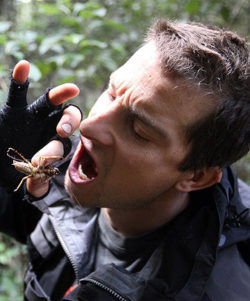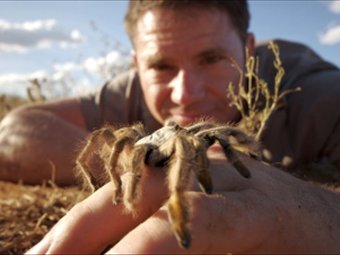TV wildlife documentary presenters are a thriving species, doing almost as well as TV chefs, and seem to be multiplying at an unprecedented rate. If you switch on Discovery Channel or Animal Planet you have a pretty good chance of seeing someone grappling with an animal before shoving it as close to the camera as possible. Usually at the same time explaining how it could kill a man in seconds if it wanted to. Then there are the “survival experts” who are more likely to eat the animal they have just thrust in front of the camera, all for the purpose of entertainment.
But why do I dislike this approach and why am I blaming these land-based individuals for encouraging bad diving habits?
 These types of shows do irritate me for a number of reasons. Firstly because I don’t really want to see a wild animal being stressed and manhandled. I know that these wildlife shows are made under the premise of education and that the animals are released back into the wild after being handled (well, except for the ones that are eaten) but the animal is probably suffering while this is going on, and there is a risk of injury to the animal. Also, I don’t need the TV presenter to actually have the animal in their hands for me to learn about the creature. I would much rather watch an “old fashioned” documentary with a voiceover by the great David Attenborough and no fearless snake-wrestling presenter in sight.
These types of shows do irritate me for a number of reasons. Firstly because I don’t really want to see a wild animal being stressed and manhandled. I know that these wildlife shows are made under the premise of education and that the animals are released back into the wild after being handled (well, except for the ones that are eaten) but the animal is probably suffering while this is going on, and there is a risk of injury to the animal. Also, I don’t need the TV presenter to actually have the animal in their hands for me to learn about the creature. I would much rather watch an “old fashioned” documentary with a voiceover by the great David Attenborough and no fearless snake-wrestling presenter in sight.
These shows also irritate me because I don’t think they help to educate scuba divers on the best way to interact with marine life. We are shown images of supposed experts and nature-lovers handling every animal that they find, so it’s understandable that the general scuba-diving public could think that these kinds of actions underwater are normal and acceptable.
Of course such behavior is not acceptable. One reason is because of the potential danger the animals might pose to the diver. Take the “Crocodile Hunter” Steve Irwin as an example. He was the pioneer of all these crazy wildlife shows who was killed in a freak accident when he was stabbed in the chest by the barb from a stingray. The chances of such a thing happening to a scuba diver is very low, but of course the chances are increased if you chase and harass the animal until it defends itself the only way it knows how.
Then of course there is the risk of harm to the animal. Project AWARE‘s Ten Tips to Protect the Ocean Planet states: “Choose not to touch, feed, handle, chase or ride anything underwater. Your actions may stress the animal, interrupt feeding and mating behavior or provoke aggressive behavior.” Even if you think the animal won’t be physically hurt, you might be affecting its behaviour in another way. Besides, it’s simply NOT NECESSARY. We are visitors to the underwater world and we should enjoy it as you would enjoy looking at a fine painting in a museum.
For the scuba diving professionals, our job is to be a role model and this responsibility should not be taken lightly when it comes to our interactions with aquatic life. If a dive guide picks up a conch shell or harasses a puffer fish, then the chances are that the divers who see this will think that this action is OK and are likely to do the same in the future.
PADI Divemasters and Instructors should remind themselves of the Code of Practice which they have agreed to follow. Amongst the obligations and responsibilities, they agree to “…abide by the practices and intent of Project AWARE’s Ten Tips…”
If you are a diver who is still tempted to touch things underwater, my advice is to restrict your actions to picking up any garbage you see and becoming involved in some Dive Against Debris surveys.
Download Project AWARE’s Ten Tips for Divers to Protect the Ocean Planet https://www.projectaware.org/sites/www.projectaware.org/files/PA_10Tips_Poster.pdf
For more information about our PADI Instructor Development Courses use the Sign Up button below to send us a message or go to our IDC page.

